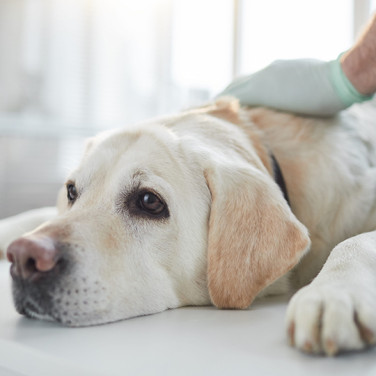DISEASES
Distemper in Dogs - Vaccine, Symptoms, and Treatment
페이지 정보
본문

What is Canine Distemper Virus?
Canine distemper virus (CDV) is a highly contagious infectious disease affecting multiple organs, resulting in respiratory, gastrointestinal, and nervous system symptoms. CDV is more common in young puppies and dogs with weakened immune systems or who have not been vaccinated against the virus properly yet. In the early stages of infection, respiratory symptoms include discharge in tears, high fever, runny nose, coughing, and digestive symptoms such as loss of appetite, vomiting, and diarrhea tend to appear. As the disease progresses, the virus eventually attacks the nervous system, resulting in circling, head tilt, nystagmus, drooling, seizures, and even paralysis may occur. A characteristic symptom of canine distemper virus is the thickening and hardening of the dog’s paw pads, also called hard pad disease. Some dogs that contract CDV may recover within 1 to 2 weeks but, once infected, usually develop permanent nervous system problems and will require long-term supportive treatment. Distemper in dogs is often fatal, and reports for the mortality rate in young puppies reach 50-80%. Prevention is possible through periodic vaccination and is essential to avoid an unnecessary demise.
Causes of Canine Distemper Virus (Distemper)
The following are the leading causes of CDV spreading amongst dogs:
- The canine distemper virus is mainly spread by direct contact with an infected animal or object, such as sharing food, water bowls, toys, etc.
- A dog can sneeze upwards of 7 meters, which makes spreading through respiratory symptoms fairly common, such as sneezing and coughing.
- Wild animals can also carry and spread the virus to your dog. Local CDV outbreaks in wild raccoon populations can put all dogs in the area at a higher risk of infection if not vaccinated.
- Lastly, infected dogs can shed the virus for several months spreading the virus unknowingly, and if pregnant, the mother can pass the virus to her puppies through the placenta.
Symptoms of Canine Distemper you should look out for
Symptoms for CDV will vary depending on the disease severity in your dog’s body. The incubation period from infection to the appearance of symptoms is about 3-7 days. The virus will initially replicate in the respiratory tract affecting the respiratory and digestive systems first. Then eventually, the central nervous system and the optic nerves. You can look for symptoms indicating how far the disease has progressed.
Stage One Distemper Symptoms:
Most dogs develop a high fever in the beginning stages of canine distemper. The initial symptoms depend on the severity of the viral infection and the dog’s immune system response.
This is a list of common stage one CDV symptoms:
- Tears with discharge
- Fever
- Clear runny nose
- Lethargy
- Loss of appetite
- Coughing
- Vomiting
- Diarrhea
- Inflammation
As the disease progresses and the above list of symptoms is present. Dogs may begin to show hyperkeratosis symptoms on the sole pad or the bridge of the nose. The pads become thick and stiff, making walking uncomfortable for your pet. This condition is called hard pad disease in dogs and can help you track the progression of the disease. A secondary bacterial infection often occurs when viruses damage the immune system, leading to additional respiratory and digestive symptoms. As the disease progresses and the central nervous system is attacked, neurological symptoms appear.
This is a list of common stage two CDV symptoms:
- Circling
- Head tilting
- Pupils shaking
- Chews its jaw
- Excessive drooling
- Muscle twitching
- Seizure
- Partial or complete paralysis
- Inflammation
Nervous system disorders or pain may cause yelping or crying.
The Dangers of Canine Distemper Virus
Canine distemper virus is a dangerous virus in general, but puppies under 4 months or dogs that have not been vaccinated are more susceptible to the fatal side of CDV. It is recommended to avoid places where people may gather their dogs and puppies, such as dog daycare, parks, etc.
Dogs infected with the canine distemper virus can shed the virus over several months, which may appear asymptomatic but can spread the infection to a vulnerable immune system or dog that is not fully protected by vaccination. An infected mother can pass the virus to her offspring through the placenta. That is why vaccinations are checked and administered if you plan to breed.
Due to the highly contagious factor of the distemper virus, it is recommended that pets are quarantined and thoroughly disinfect all items and environments your dog inhabits if you live with multiple pets.
Due to the lethal nature of CDV, it is good to be aware of the accompanying symptoms to treat the virus as soon as possible. Some diseases cause diarrhea, vomiting, respiratory issues, and neurological symptoms, but few conditions cause all of these symptoms simultaneously. You must immediately visit the vet if you notice these symptoms occur together. Neurological symptoms, dehydration, and secondary infections can occur if left without treatment. Even when a dog recovers from the canine distemper virus, there may be permanent, irreversible damage to the nervous system.
Can You Treat Canine Distemper Virus at Home?
Canine distemper virus is a fatal disease that requires early veterinary treatment if symptoms appear simultaneously.
How is the Canine Distemper Virus Diagnosed?
A veterinarian will make a comprehensive diagnosis based on whether the patient has been vaccinated, the patient's age and health condition, and the clinical symptoms present.
For an accurate diagnosis, the following tests may be performed:
-
Antibody test (PCR):
A PCR test by determining samples collected from respiratory secretions, blood, urine, and bone marrow according to clinical symptoms and time of infection. -
Antigen test (ELISA)
Antibody titer test in blood and cerebrospinal fluid (CSF) - Plantar pad biopsy
- Blood tests
- Radiographs
Such as X-rays can be used to check overall health and the presence or absence of other diseases.
What Kind of Treatment is Available for Canine Distemper Virus?
The veterinarian will comprehensively evaluate the dog's health condition and symptoms and proceed with the appropriate treatment. Since no drug can cure the canine distemper virus, supportive treatment is conducted to help the patient's immune system fight the virus and recover.
The following are supportive treatments for the canine distemper virus:
- Fluid and electrolyte therapy to correct dehydration and replenish nutrition due to vomiting and diarrhea
- Antibiotics can be administered because secondary bacterial infections can occur. Symptomatic treatment is performed according to the symptoms present since antibiotics can affect various organs.
- Anti-inflammatory drugs may be prescribed if there are respiratory symptoms,
- Oxygen or a nebulizer may be used to help prevent damage to the respiratory tract mucosa and help discharge infectious agents and secretions present in the respiratory tract.
- Antiemetic or antidiarrheal medications may be prescribed to stop vomiting and diarrhea.
- Anticonvulsant drugs may be prescribed if seizures occur.
Survival rates depend on the severity of the virus and the dog's immune system response. In some cases, recovery occurs within 10 days, but in others, neurological symptoms can persist for weeks or months.
How can the canine distemper virus be prevented?

Canine distemper virus can be effectively prevented through vaccination. One of the basic vaccination administered to all dogs is called the DHPP vaccine, which includes the D for Distemper.
Initial vaccination varies from country to country in guideline standards. Still, on average, it is recommended to start at about 6 weeks, then shots in 3-4 week intervals, and continue until 14-16 weeks of age. This vaccine period progresses until antibodies from the mother's milk drop and the puppy’s immune system begins to mature.
The following is a list of ways you can help prevent your dog from contracting the canine distemper virus:
- After the initial vaccination, it is recommended to receive a booster vaccine within a year and then a booster vaccine at least once every 2 years. After vaccination, the antibody titer present in the body can be tested and prompted for a booster to ensure protection. In some cases, appropriate antibodies are not produced even after vaccination, resulting in infection with the virus.
- It is best to avoid places where there are many dogs until you are fully vaccinated.
- Contact with wild animals should be avoided at all times.
- If multiple pets live together, it is recommended that all animals be vaccinated to prevent infection, especially young dogs.
Find out more about your dog’s disease or symptoms in the Buddydoc Library!

The Buddydoc library is filled with everything you’d want to know about each symptom and disease your pet may experience. If you would like to find out more about the causes, signs, treatments, preventions, and more for your dog’s disease. Try out the Buddydoc app and search your pet’s symptom or disease in the Buddydoc library.













